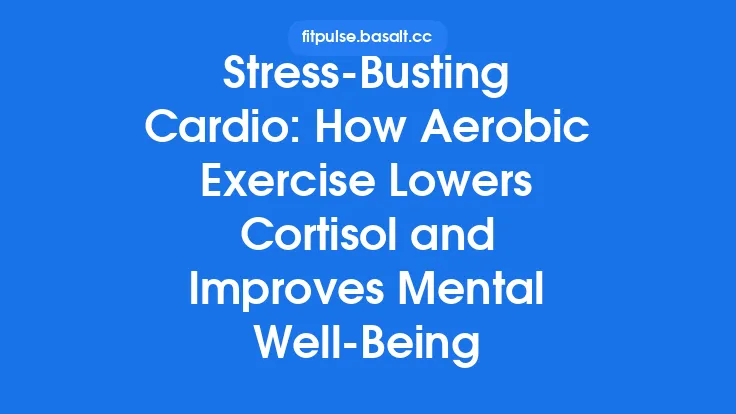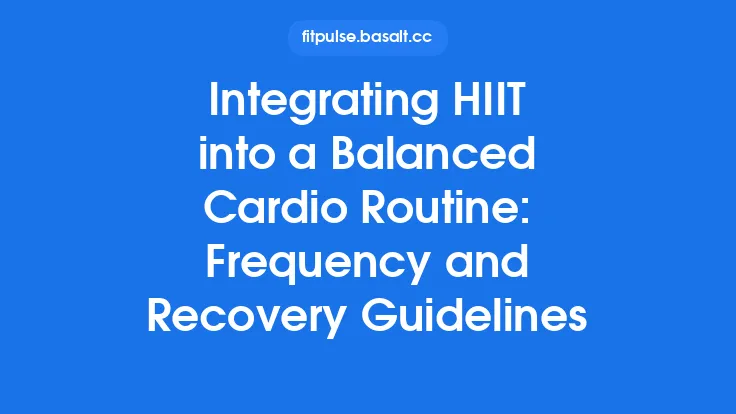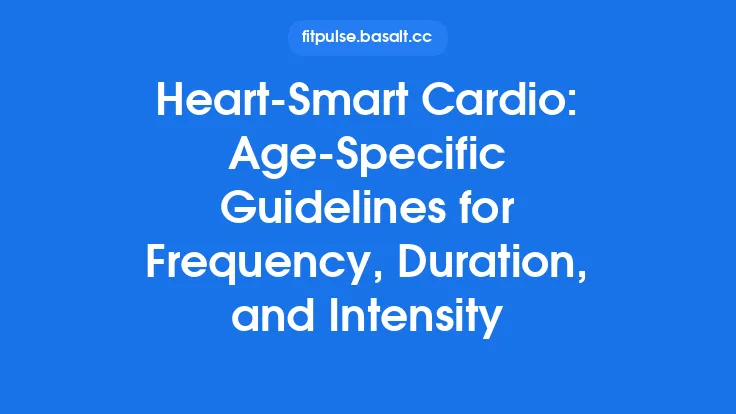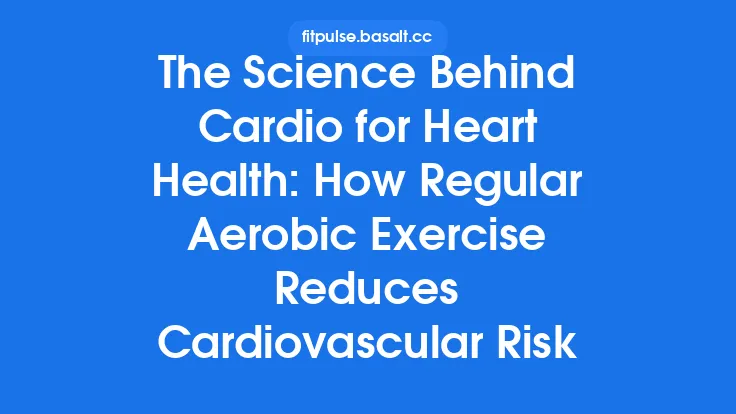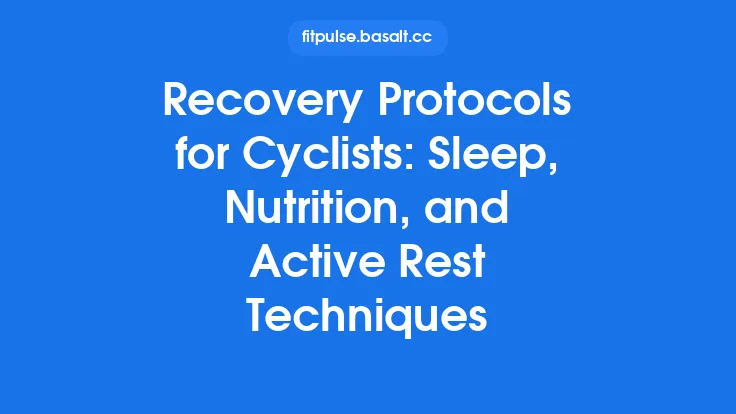Regular aerobic exercise is one of the most accessible tools for enhancing both the quality of your nightly rest and your ability to cope with everyday stressors. While many people associate cardio primarily with cardiovascular fitness or weight control, its influence reaches far deeper into the body’s regulatory systems. By consistently engaging in moderate‑to‑vigorous aerobic activity, you set off a cascade of physiological and neurobiological changes that promote more restorative sleep and a calmer, more resilient stress response. Below, we explore the science behind these benefits and provide practical guidance for integrating cardio into a lifestyle that supports optimal rest and stress management.
The Connection Between Physical Activity and Sleep Architecture
Sleep is not a monolithic state; it consists of several stages that cycle throughout the night, each serving distinct restorative functions:
| Stage | Approx. Duration (per cycle) | Primary Functions |
|---|---|---|
| N1 (light sleep) | 5–10 % | Transition from wakefulness |
| N2 (light sleep) | 45–55 % | Memory consolidation, synaptic pruning |
| N3 (deep, slow‑wave sleep) | 15–25 % | Physical recovery, growth hormone release |
| REM (rapid eye movement) | 20–25 % | Emotional processing, dreaming |
Regular cardio has been shown to increase the proportion of time spent in N2 and N3 stages, while also stabilizing REM sleep. The mechanisms are multifactorial:
- Energy Expenditure and Homeostatic Sleep Drive – Physical activity raises the body’s overall energy demand, amplifying the homeostatic pressure to sleep (the “sleep debt” that builds up during wakefulness). This heightened drive encourages a quicker onset of sleep and deeper slow‑wave activity later in the night.
- Adenosine Accumulation – Exercise accelerates the production of adenosine, a neuromodulator that builds up in the brain during wakefulness and promotes sleepiness. Elevated adenosine levels after cardio help signal the brain that it is time to transition into sleep.
- Neuroplastic Adaptations – Aerobic training enhances synaptic plasticity, particularly in the hippocampus. Improved neural efficiency reduces the need for prolonged REM periods dedicated to memory processing, allowing for a more balanced distribution of sleep stages.
How Cardio Influences the Body’s Internal Clock
The circadian system, anchored by the suprachiasmatic nucleus (SCN) in the hypothalamus, orchestrates the 24‑hour rhythm of hormone release, body temperature, and alertness. Regular aerobic activity serves as a potent “zeitgeber” (time cue) that can fine‑tune this internal clock:
- Phase Shifting – Consistent exercise performed at the same time each day can shift the timing of the circadian rhythm, advancing or delaying the sleep‑wake cycle to better align with personal schedules.
- Amplitude Enhancement – Cardio amplifies the amplitude of circadian rhythms, making the peaks (e.g., daytime alertness) and troughs (e.g., nighttime sleep propensity) more pronounced. A stronger amplitude translates to clearer signals for when to be awake and when to wind down.
Research indicates that exercising in the late afternoon or early evening (approximately 4–7 p.m.) often yields the most robust phase‑advancing effect for individuals who struggle with late‑night insomnia, while morning workouts can help “reset” delayed sleep phase patterns.
Temperature Regulation and Sleep Onset
Core body temperature follows a predictable pattern: it rises during the day, peaks in the late afternoon, and then declines in the evening to facilitate sleep. Cardio influences this thermoregulatory cycle in two key ways:
- Post‑Exercise Cooling – After a cardio session, the body initiates active cooling to return core temperature to baseline. This cooling period mimics the natural temperature drop that signals the brain to initiate sleep, thereby shortening sleep latency (the time it takes to fall asleep).
- Peripheral Vasodilation – Aerobic activity promotes blood flow to the skin, enhancing heat dissipation. The resulting peripheral vasodilation further supports the decline in core temperature, reinforcing the body’s readiness for sleep.
To maximize this benefit, aim to finish moderate‑intensity cardio at least 60–90 minutes before bedtime, allowing sufficient time for the cooling process to complete.
Hormonal Shifts Beyond Cortisol: Melatonin, Growth Hormone, and Endorphins
While cortisol is a well‑known stress hormone, cardio also modulates several other hormones that directly impact sleep and stress resilience:
- Melatonin – The “darkness hormone” is secreted by the pineal gland in response to reduced light exposure. Regular aerobic exercise has been shown to increase nocturnal melatonin amplitude, improving both sleep onset and overall sleep quality.
- Growth Hormone (GH) – Peak GH secretion occurs during deep (N3) sleep. Cardio stimulates GH release both acutely (during the workout) and chronically (by enhancing slow‑wave sleep), supporting tissue repair, muscle recovery, and metabolic health.
- Endorphins and Endogenous Opioids – Aerobic activity triggers the release of β‑endorphin, which produces a sense of euphoria and pain relief. Elevated endorphin levels can reduce the perception of stress and promote a relaxed mental state conducive to sleep.
- Serotonin – Cardio increases the availability of tryptophan, a precursor to serotonin, which in turn is converted to melatonin in the dark. Higher serotonin levels improve mood stability and reduce anxiety, indirectly supporting better sleep.
Autonomic Balance: Shifting from Sympathetic to Parasympathetic Dominance
The autonomic nervous system (ANS) comprises two branches:
- Sympathetic Nervous System (SNS) – Drives the “fight‑or‑flight” response, increasing heart rate, blood pressure, and alertness.
- Parasympathetic Nervous System (PNS) – Promotes “rest‑and‑digest” activities, slowing heart rate and fostering relaxation.
Chronic stress skews the ANS toward sympathetic dominance, making it difficult to unwind at night. Regular cardio induces several adaptations that rebalance the ANS:
- Heart Rate Variability (HRV) Enhancement – HRV is a non‑invasive marker of autonomic flexibility. Aerobic training consistently raises HRV, indicating stronger parasympathetic tone and a more adaptable stress response.
- Baroreflex Sensitivity Improvement – The baroreflex helps regulate blood pressure and heart rate. Cardio strengthens this reflex, allowing the body to transition more smoothly from an alert state to a relaxed state.
- Reduced Resting Heart Rate – A lower resting heart rate reflects increased vagal (parasympathetic) influence, which is associated with quicker sleep onset and deeper sleep stages.
Practical Guidelines for Timing and Type of Cardio to Optimize Sleep
| Variable | Recommendation | Rationale |
|---|---|---|
| Intensity | Moderate (40‑70 % VO₂max) for 30‑45 min, 3‑5 times/week | Balances energy expenditure with manageable recovery, maximizing sleep‑promoting hormonal shifts without overstimulating the nervous system. |
| Duration | 30‑60 min per session | Sufficient to trigger adenosine buildup and temperature regulation, yet short enough to avoid excessive fatigue that could disrupt sleep. |
| Time of Day | Late afternoon/evening (4‑7 p.m.) or early morning (6‑9 a.m.) | Aligns with natural circadian temperature decline (evening) or reinforces morning phase‑advancement (early). |
| Mode | Continuous steady‑state (jogging, cycling, brisk walking) or interval training with moderate work‑to‑rest ratios (2:1) | Both modalities improve autonomic balance; intervals can be shorter for those with limited time, provided total weekly volume is maintained. |
| Cool‑Down | 10‑15 min of low‑intensity activity + gentle stretching | Facilitates post‑exercise cooling and parasympathetic activation, smoothing the transition to bedtime. |
| Environment | Well‑ventilated, natural light exposure (if daytime) or dim lighting (if evening) | Light exposure influences melatonin; bright daylight during morning workouts supports circadian alignment, while dim lighting in the evening avoids suppressing melatonin. |
Managing Daily Stress Through Regular Cardio: Psychological and Neurological Pathways
Beyond the physiological mechanisms, cardio exerts profound effects on the brain’s stress circuitry:
- Neurogenesis in the Hippocampus – Aerobic exercise stimulates the production of brain‑derived neurotrophic factor (BDNF), fostering the growth of new neurons. A healthier hippocampus improves contextual memory and emotional regulation, making everyday stressors feel less overwhelming.
- Prefrontal Cortex (PFC) Strengthening – Regular cardio enhances PFC activity, which is responsible for executive functions such as planning, impulse control, and appraisal of threats. A more robust PFC can reinterpret stressful situations, reducing perceived intensity.
- Amygdala Desensitization – The amygdala, the brain’s alarm center, shows reduced reactivity after consistent aerobic training. This dampening effect translates to lower emotional reactivity and quicker recovery from stressful events.
- Allostatic Load Reduction – Allostasis refers to the body’s ability to achieve stability through change. Chronic stress raises allostatic load, leading to wear and tear on multiple systems. Cardio lowers this load by improving metabolic efficiency, vascular health, and immune function, thereby buffering the impact of stressors.
Building a Sustainable Cardio Routine for Better Rest and Resilience
- Start with a Baseline Assessment – Track your current sleep patterns (using a sleep diary or wearable) and perceived stress levels (e.g., via the Perceived Stress Scale). This data will help you gauge progress.
- Set Incremental Goals – If you’re new to cardio, begin with 10‑15 min walks, gradually adding 5‑minute increments each week until you reach the target 30‑45 min window.
- Choose Enjoyable Activities – Preference drives adherence. Whether it’s dancing, swimming, or hiking, the key is consistent movement that raises heart rate into the aerobic zone.
- Integrate Social Elements – Group classes or a walking buddy can boost motivation and provide additional stress‑relief through social connection.
- Monitor Recovery – Pay attention to signs of overtraining (persistent fatigue, irritability, fragmented sleep). If these appear, reduce intensity or add an extra rest day.
- Leverage Technology Wisely – Use heart‑rate monitors to stay within the desired intensity range, but avoid obsessively tracking every metric, which can itself become a stressor.
- Re‑evaluate Quarterly – Review sleep and stress data every three months, adjusting frequency, duration, or timing of cardio as needed to maintain optimal benefits.
Common Pitfalls and How to Avoid Them
| Pitfall | Why It Undermines Benefits | Solution |
|---|---|---|
| Exercising Too Close to Bedtime | Elevated core temperature and sympathetic activation can delay sleep onset. | Finish cardio at least 60‑90 min before lights‑out; incorporate a cool‑down and calming routine (e.g., reading, gentle stretching). |
| Excessive High‑Intensity Sessions | Overly intense workouts can spike adrenaline and cortisol, counteracting stress‑reduction goals. | Balance high‑intensity intervals with moderate‑intensity days; keep total weekly high‑intensity volume under 20 % of total cardio time. |
| Neglecting Hydration and Nutrition | Dehydration or low blood glucose can cause nighttime awakenings and heightened stress perception. | Re‑hydrate throughout the day and consume a balanced post‑exercise snack (protein + complex carbs) within 30 min of finishing. |
| Monotonous Routine | Boredom reduces motivation, leading to missed sessions and loss of sleep/stress benefits. | Rotate activities, explore new routes, or incorporate music/podcasts to keep sessions engaging. |
| Ignoring Individual Chronotype | “Night owls” may find evening cardio disruptive, while “morning larks” may struggle with early sessions. | Align cardio timing with your natural preference; experiment with different windows to discover what best supports your sleep. |
Frequently Asked Questions
Q: Can cardio replace other stress‑management techniques (e.g., meditation or therapy)?
A: Cardio is a powerful adjunct but not a wholesale replacement. It works synergistically with mindfulness, counseling, and other strategies to create a comprehensive stress‑reduction toolkit.
Q: How many days per week are needed to see improvements in sleep?
A: Most individuals notice measurable changes after 2‑3 consistent sessions per week. Full adaptation—optimizing sleep architecture and autonomic balance—typically emerges after 4‑6 weeks of regular training.
Q: Is there a “best” type of cardio for sleep, such as running versus cycling?
A: The specific modality matters less than the intensity, duration, and timing. Choose the activity you enjoy and can sustain consistently.
Q: Will cardio help if I have a diagnosed sleep disorder (e.g., insomnia or sleep apnea)?
A: Aerobic exercise can improve sleep quality in many insomnia cases and may reduce apnea severity by aiding weight management and enhancing airway muscle tone. However, it should complement— not replace—medical treatment and professional guidance.
Q: Does cardio affect the need for sleep?
A: Regular cardio can improve sleep efficiency, meaning you may feel more rested with the same or slightly less total sleep time. It does not eliminate the fundamental need for adequate sleep; most adults still require 7‑9 hours per night.
Closing Thoughts
Integrating regular aerobic exercise into your routine is a scientifically grounded, low‑cost strategy for enhancing sleep quality and fortifying your resilience to stress. By understanding how cardio interacts with circadian rhythms, temperature regulation, hormonal balance, and autonomic function, you can tailor workouts that not only boost cardiovascular fitness but also nurture the restorative processes that underpin mental clarity, emotional stability, and overall well‑being. Start modestly, stay consistent, and let the rhythm of your heart guide you toward nights of deeper, more refreshing sleep and days marked by calm, focused energy.
